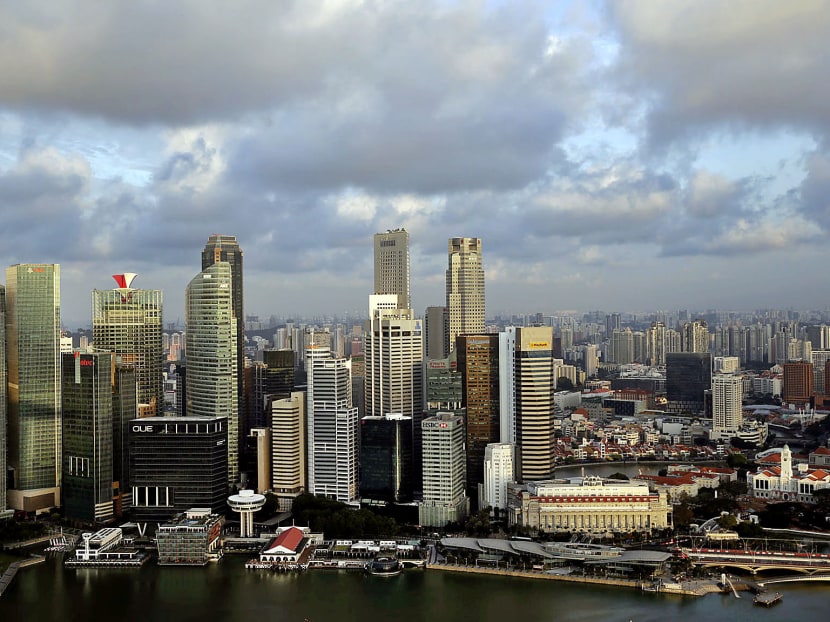Singapore’s 2019 economic growth likely to be weaker but global economy ‘not headed for a crash’, says MAS chief
SINGAPORE — The continuing tensions between the United States and China have stalled three of the world’s growth engines — trade, manufacturing and investments — which means the Singapore economy is likely to end the year weaker than previously expected.
SINGAPORE — The continuing tensions between the United States and China have stalled three of the world’s growth engines — trade, manufacturing and investments — which means the Singapore economy is likely to end the year weaker than previously expected.
This was the warning from Mr Ravi Menon, managing director of the Monetary Authority of Singapore (MAS), the country’s central bank, on Thursday (June 27).
He added that the Ministry of Trade and Industry and the MAS are reviewing the 1.5 to 2.5 per cent economic growth forecast for this year — which was narrowed last month from 1.5 to 3.5 per cent.
Still, Mr Menon, who was speaking to reporters at a briefing on the MAS’ annual report, stressed that the global economy is not headed for a crash, as it is supported by healthy private consumption in Asia and other major economies and a resilient services sector worldwide.
COULD SINGAPORE’S GROWTH FORECAST BE TRIMMED?
Mr Menon, when asked if the Government could trim the economic growth forecast further, said the authorities needed to carefully study the incoming data and assess the external conditions and risks.
“At this point, it is too early to say where we are going to end up,” he said.
On when the forecast would be revised, MAS chief economist Edward Robinson said it was important to consider the economy’s performance in the second quarter of the year. This data set will be available in July, he noted.
Mr Menon said recent indicators suggest growth in the second quarter of 2019 could be lower than that in the first three months of the year, when the economy expanded by 1.2 per cent.
The present forecast of 1.5 to 2.5 per cent growth for the whole year hinges on the economy stabilising in the third quarter and a modest pick-up thereafter, he said.
But he added that these are unlikely to offset the weakness seen in the first half of the year.
OCBC Bank economist Selena Ling said the latest review, coming quite soon after the last, reflects the deterioration of the external economic environment, with US-China trade talks breaking down and rising downside risks.
The forecast could shrink to between 0.5 and 1.5 per cent, or between 1 and 2 per cent, but it is “anyone’s guess”, Ms Ling said.
GLOBAL MANUFACTURING DOWNTURN
In a grim assessment of the economic situation, Mr Menon noted that global manufacturing is in a “synchronised downturn”, global trade volumes have declined for two straight quarters, and global investments have suffered from weakening business confidence.
“If the trade impasse between the US and China drags on and further tariff measures are imposed, growth in the second half of 2019 is likely to be weaker than earlier envisaged,” he said.
The impact of the trade conflict will be felt across Asia through disruptions in supply chains, a slowdown in China — which would have significant spillover effects on the rest of Asia — and firms holding back on their capital-expenditure plans, he added.
Against this backdrop, Singapore’s gross domestic product growth for the year is likely to be weaker than earlier forecast.
Still, he noted that it is important to look beyond the headline numbers and study the composition of growth in the domestic economy.
Last year, he said, Singapore’s economic growth was driven by trade and modern services, while the domestic-industries sector was flat.
This year, while trade is decelerating, modern services is holding up, while the domestic-industries sector is gradually recovering.
Buoyed by healthy regional demand and more investments in digitalisation, modern services — which include financial, information and communications, and professional services — will be the main driver of growth in 2019, said Mr Menon.
Domestic industries, such as retail and construction, will make a “modest, positive” contribution to overall growth, even as trade-related sectors bear the brunt of deepening trade tensions, for instance.
Ultimately, he said, the Singapore economy is in for a “rougher ride”, but it is well placed to do so. “We need to be alert, but there is no need to be alarmed,” he added.
In the last financial year, the MAS recorded a net profit of S$19.2 billion, more than thrice as high as the S$5.3 billion it reported in the previous financial year.
It recorded investment returns of S$26.2 billion from official foreign reserves amassed from its foreign-exchange-intervention operations, which are key to Singapore’s monetary policy. These comprised S$25.2 billion in foreign investment gains, with the remaining S$1 billion from positive currency-translation effects.
After deducting S$3.1 billion for expenses in domestic and other operations, its operating profit came in at S$23.1 billion. It contributed S$3.9 billion from that amount to the Government’s consolidated fund.







